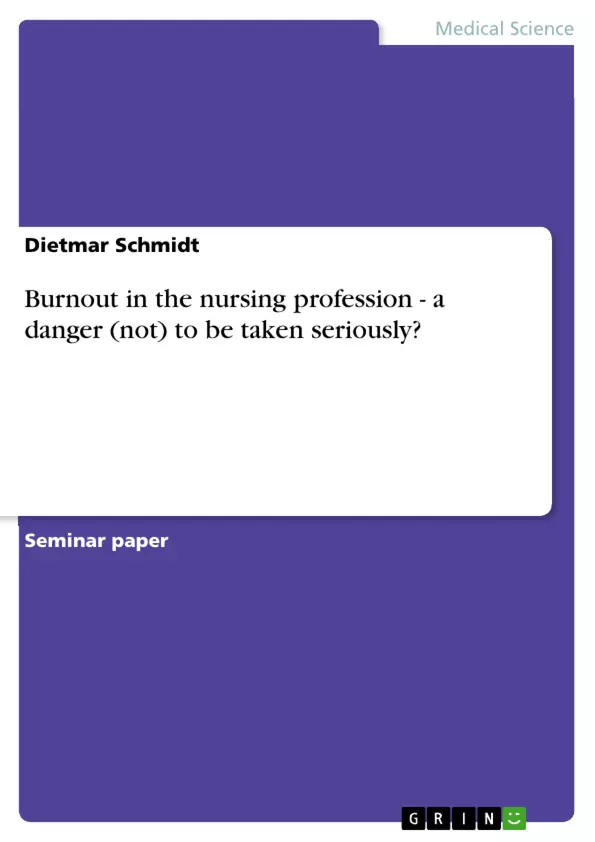Problem description and objective: Everyday´s stress pushes people more and more to their limits. The consequence is an intrinsic and physical fatigue of those affected. The presented work scrutinises currents studies with regards to the danger of getting sick with a burnout, as well as alternative therapies and interventions, which can help reducing the risk of a burnout.
Method: An investigation of the data bases PubMed, Gerolit and DIMDI was performed from February 2010 to June 2010. Inquiries by hand were done in the libraries of the University of Vienna and the medical hospital of the general hospital of the city of Vienna.
Results: Time pressure, lack of support from colleagues and superior, a work pace too high and night shifts are the main indicators for care attendants feeling exhausted and consequently not capable any more. Teachers are also especially susceptible to get sick with burnout, as dealing with problem students, classes with too many students, lack of appreciation and demanding expectations from parents make some pedagogues feeling spent after one year in their job, thinking about a job change. There are several therapies which can be used to reduce the risk of a burnout. Most of all, relaxation techniques like autogenous training or progressive muscle relaxation have proven themselves to be especially successful.
Conclusion: Reduced working hours, more support from colleagues and the inclusion of relaxation exercise into the daily routine can help to prevent burnout, or reduce symptoms of a burnout already present.
Inhaltsverzeichnis (Table of Contents)
- 1 Introduction
- 2 Methodology
- 2.1 Question
- 2.2 Literature research
- 3 Results
- 3.1 The probability to get sick with burnout
- 3.2 Proofs of effectiveness of possible therapies for the reduction of the burnout risk.
- 3.3 Summary of the results
- 4 Discussion with limitation
- 5 Outlook for the practice
- 6 List of tables and figures
- 7 References
Zielsetzung und Themenschwerpunkte (Objectives and Key Themes)
This work aims to examine the risk of burnout in healthcare professionals, specifically nurses and teachers, through a review of existing literature. The research delves into the causes, symptoms, and potential therapies for reducing burnout risk.
- Burnout as a syndrome in healthcare professions
- Factors contributing to burnout in nurses and teachers
- Effectiveness of therapies and interventions for burnout prevention
- Implications for promoting well-being in healthcare settings
- Strategies for addressing burnout risk in the workplace
Zusammenfassung der Kapitel (Chapter Summaries)
The introductory chapter explores the origins of the term "burnout" and provides an overview of its evolution as a scientific concept. It highlights the distinction between the American and European interpretations of the term, emphasizing the cultural context. The chapter delves into the work of Herbert J. Freudenberger and Christina Maslach, key figures in defining burnout, and introduces the Maslach Burnout Inventory (MBI).
The methodology section outlines the research approach, specifying the databases consulted (PubMed, Gerolit, and DIMDI) and the search period (February 2010 to June 2010). It also describes the manual research conducted in libraries at the University of Vienna and the Vienna General Hospital.
The "Results" chapter presents findings regarding the likelihood of burnout in various professions, focusing on nurses and teachers. It explores specific factors, such as time pressure, lack of support, and demanding expectations, that contribute to burnout. This section also examines the effectiveness of different therapies, particularly relaxation techniques like autogenous training and progressive muscle relaxation.
The "Discussion with limitation" chapter explores the findings in detail, analyzing the strengths and limitations of the research. The concluding "Outlook for the practice" chapter suggests practical implications of the findings for preventing burnout and improving the well-being of healthcare professionals.
Schlüsselwörter (Keywords)
The central keywords of this work include burnout, nurses, teachers, therapies, interventions, relaxation techniques, well-being, and healthcare settings. These terms encompass the core concepts and research focus of the study, emphasizing the importance of understanding and addressing the risk of burnout in the healthcare profession.
- Quote paper
- BScN Dietmar Schmidt (Author), 2011, Burnout in the nursing profession - a danger (not) to be taken seriously?, Munich, GRIN Verlag, https://www.grin.com/document/173455



